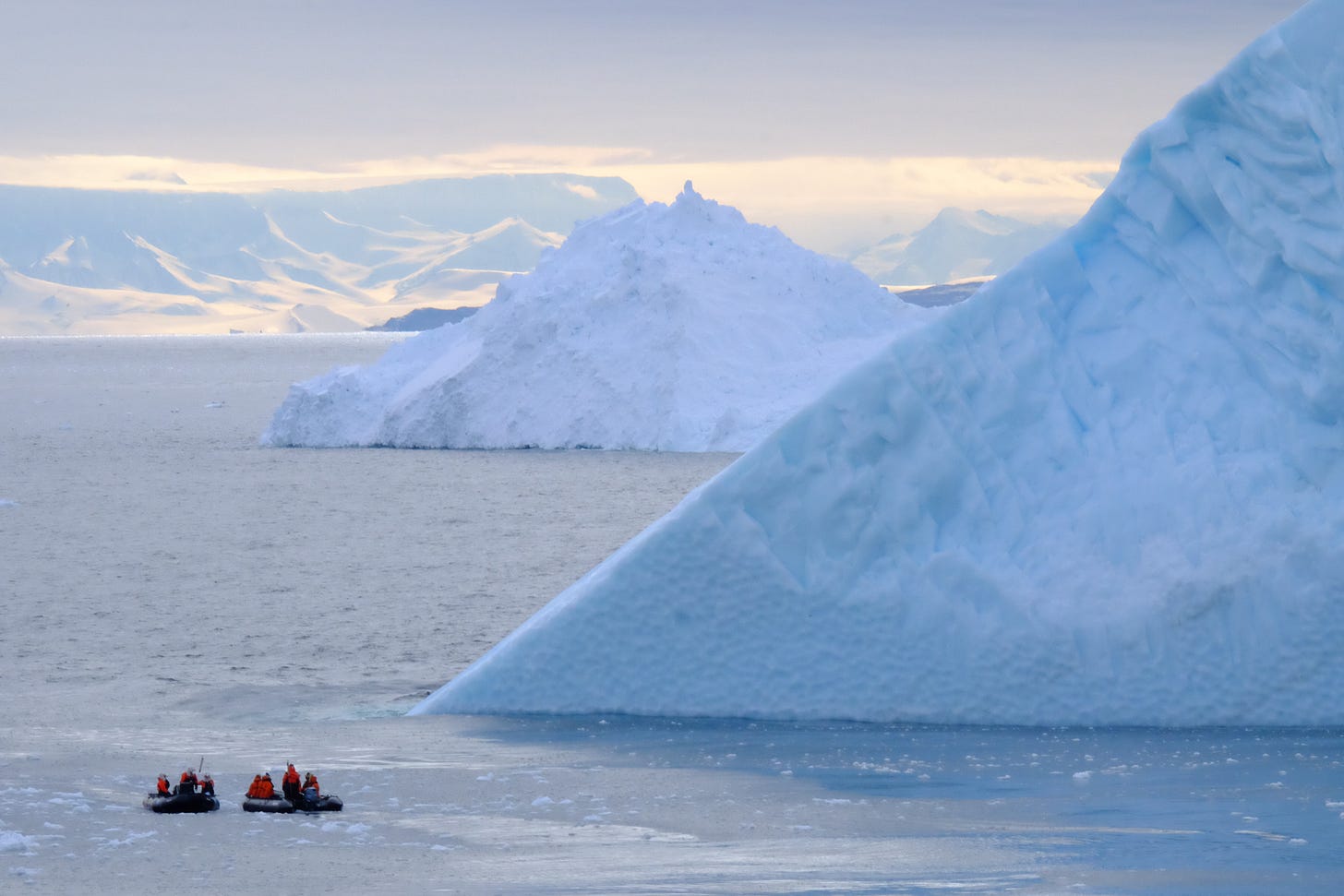[I’ll be writing more about this in the coming months, but the short version is that I am finally living my childhood dream, feeding the same fascination that led me to write my second novel Terra Nova, and I’m in Antarctica. I sailed from Dunedin, New Zealand on a super cool Lindblad/National Geographic ship aptly called the Endurance, and after eight days at sea (and with stops on some of the Sub-Antarctic Islands), we reached the continent itself at Cape Adare. Since then, we’ve been going further and further south, into the Ross Sea. We’ll cross the Drake’s Passage about two weeks from now and will end the trip in Ushuaia, Argentina.]
On a Zodiac inflatable boat at the edge of Antarctica’s Ross Sea, I had a fascinating exchange with Gabi, a naturalist and historian and leader in New Zealand’s Antarctic Heritage Trust, about the icebergs in front of us. She explained the process of melting and freezing that the bergs can undergo, and how that affects their many surfaces and how those effects are also expressed in the colors of the ice. It was complicated, and I was trying to follow along while managing my ever-present awe at the views all around me. One thing she said stands out.
They tend towards instability.
“They tend towards instability,” Gabi said. Meaning that, as the icebergs melt, they tip over, sending another side into the water and a new side to the surface. And then, though they achieve stability for some period of time1, the bergs continue to melt—which means they tip once more. This process is repeated over and over, presumably for the life of the iceberg—which can be hundreds of years.
My simplified understanding of many processes in our world is that, while everything everywhere moves towards greater entropy (see: laws of thermodynamics), processes that take place locally, on the small scale, can seem to achieve equilibrium. If a hot fluid mixes in with a cold fluid, the temperature of the combination will level off. If a hot room is opened to a cold one, the air temperature will balance in both rooms (given enough time). Our human, local experience tells us that extremes will find a middle. The ball rolled from one height to another will settle at the bottom of the arc.
Yet here, in the Ross Sea, among the icebergs and bergy bits and growlers2, I could see before my very eyes a thing whose condition was the opposite of what I’ve always seen. Granted, I couldn’t see the melting or the tipping over—thankfully, because a tipping-over iceberg is not something you want to be next to in a 15-foot boat. But still, it was happening. While the ball in the arced ramp or the air in two rooms or the liquids in a cup should achieve a stability of motion, the iceberg is always moving, always changing. Restless, it expresses entropy all. the. time. It is never ever stable.
The surface of an iceberg tells that story. You’ll see a soaring facade rising up over a hundred feet pocked with dimples—because that surface was the berg’s bottom, and the dimples show where underwater melting occurred over time. Or you’ll see a smooth side, cut sharp like a piece of halva, and you’ll realize that that used to be the top of the ice shelf the berg broke off of. An iceberg’s surfaces tell the story of the change they’ve gone through and are continuously undergoing. It’s beautiful.
A note on time (see footnote 1). With daily lectures here on the ship I’m on for what will be a total thirty days, I know more than I knew about icebergs (and many other Antarctic things) than I did before. But my knowledge of my own ignorance grows too. What I can say is that my simple statement “some period of time” is bafflingly difficult to comprehend when you’re in Antarctica. I’m looking right now at an island in the Ross Sea (Franklin Island), capped with a layer of ice and some snow that has been there for perhaps generations. The Drygalski Ice Tongue we sailed along (and visited close up in Zodiacs) yesterday is hundreds, likely thousands, of years old. (Everything about the Drygalski exists on an epic scale.) When things change in this environment, they do sometimes change relatively quickly over the last decade(s) (water temperature, air temperature), but they also change very, very slowly. And they have also lived a very, very long time.
Being on a ship for thirty days, where the current weather notes for sunrise and sunset are “no sunrise. no sunset” will blow your mind, when it comes to time. We are 18 hours ahead of most of you reading this. We are on Day 11 at sea. We are still 17 days from Ushuaia, Argentina. We made friends 11 days ago. We feel we have known those friends all our lives. We’re approaching the very middle of this journey, and we’re finding our own stabilities (routines and social-circle gravitations)—while all around us, at speeds both fast and impossibly slow, the world is changing, always changing.
more about this later
These are actual terms for ice chunks of different sizes. A growler is an ice chunk less than 3 meters high. A bergy bit is a chunk between 1 and 3 meters in size. An iceberg is any chunk larger than 3 meters high.








Loving the updates on FB and reflection here. If you do a talk about this unforgettable experience, I’d be thrilled, esp if it were on Zoom. The pictures and annotations are beautiful and fascinating!
I did that in Egypt too. Photos often just don’t quite capture just how unbelievably amazing things are. Still can’t wait to see them. I had no idea ice bergs rotated like that. I keep using amazing but it fits.